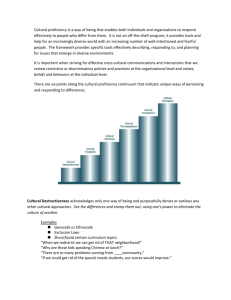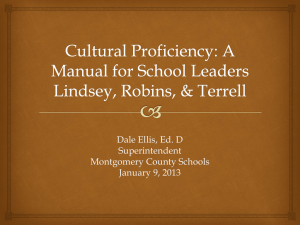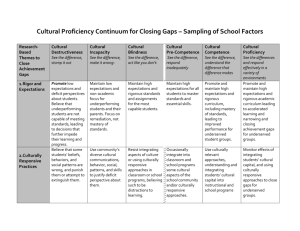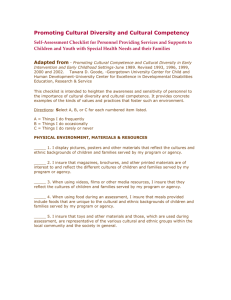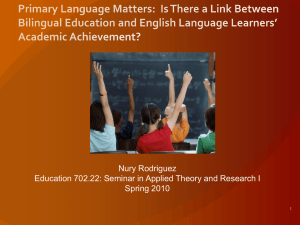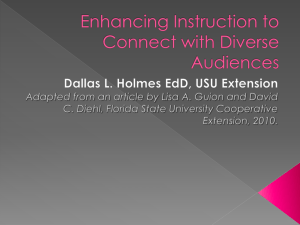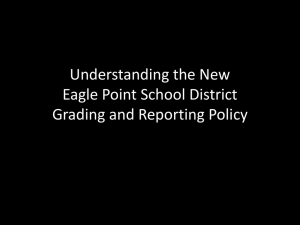Culturally proficient teaching
advertisement
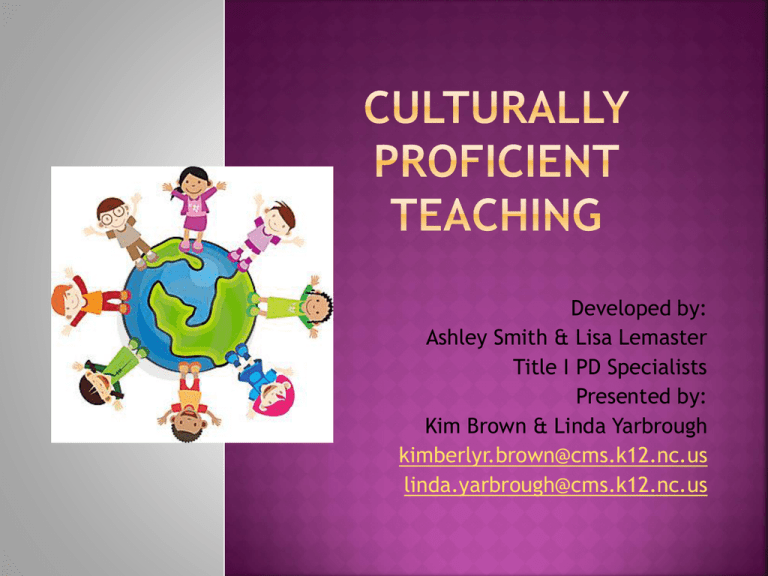
Developed by: Ashley Smith & Lisa Lemaster Title I PD Specialists Presented by: Kim Brown & Linda Yarbrough kimberlyr.brown@cms.k12.nc.us linda.yarbrough@cms.k12.nc.us Welcome & Introductions Class Meeting Overview Culture is an Iceberg Culturally Relevant Pedagogy Cultural Jigsaw Activity Marzano’s Systems of Thinking Deficit vs. Asset Models LUNCH (on your own) Surveys & Scenarios Case Studies Respect Inclusive Practices Wrap-Up & Reflections Some parts of culture are visible and easily seen… This hidden part of the culture has been termed ‘deep culture’… With your table group, you will now create your own culture iceberg. Be sure to include specific ‘indicators’ that make up the visible and invisible parts of the iceberg. language, Making culturally relevant pedagogy a reality in your classroom… Ethnicity Nationality Race National Origin On an index card, reflect on how YOU would define ‘cultural proficiency’. All children access information differently. Self System: (key that opens) The control center for thinking and action; getting the student to ‘buy in’ to engagement in the learning task. Meta-cognitive System: (engine that starts) The engine of learning; instructional techniques used by teachers that have an impact; involves goalsetting, processing, and monitoring. Cognitive System: (wheels that get us moving) This system is about ‘doing the task’; the student must figure out what they know, what they do not know, what they need to learn how to do, and how to do it. Declarative- consists of information Procedural- consists of skills and processes When the students engage the cognitive system, they will make their own meaning (filtered by their culture) of content, which results in learning. Now, it’s your turn! P-I-G: develop a lesson that goes through all three levels of Marzano’s Systems of Thinking. Old Paradigm: Deficit ModelBased on something missing in the child: Deprived (deficient) Incapable (failures) New Paradigm: Asset ModelBased on the strength of the child: Culturally diverse (rich in spirit & unique) Capable (high achievers) Self-motivated (engaged) Resilient (making it, against the odds…) Unmotivated (off-task) At-risk (beat due to circumstances) Now, revise your previous definition on cultural proficiency to reflect your new learning. Are you using ‘asset language’? See you back at 1:00! TIPS 1. Standard texting rates only (worst case US $0.20) 2. We have no access to your phone number 3. Capitalization doesn’t matter, but spaces and spelling do TIP Capitalization doesn’t matter, but spaces and spelling do Take a moment to jot down what your own personal assumptions and beliefs are. This is for your own PERSONAL reflection and will not be shared… A Day in the Life of Dorothy or Bonnie •Read aloud your person’s autobiography to your partner. •After reading, discuss these questions: -What differences did you find in their two lives? -What responsibilities do you have to learn about the experiences that other cultures confront daily? -What are some ways that you can make yourself accountable for including all students? What does respect look like in different cultures? Read the article on respect and be prepared to discuss. Respect is culturally influenced. The key is: we should not make assumptions or be presumptuous when it comes to respect. Paideia Seminar Discussion: Question 1:(round robin): Besides the word respect, what word popped out at you while reading the article? Question 2: How have you seen the different meanings of respect played out in your classroom? Question 3: What are some ways you can consider changing existing practices in your classroom to meet the needs of your students and families when addressing respect? Make a Tri-fold I Liked … I Learned … Lingering Questions … Developed by: Ashley Smith & Lisa Lemaster Title I PD Specialists Presented by: Kim Brown and Linda Yarbrough kimberlyr.brown@cms.k.12.nc.us linda.yarbrough@cms.k12.nc.us Level 1: The Contributions Approach Focuses on heroes, holidays, and discrete cultural elements. Example: A school has a multicultural fair one day during the last week of school, featuring food and games from various cultures. Cultural elements are not integrated into the curriculum throughout the school year. Level 2: The Additive Approach Content, concepts, themes, and perspectives are added to the curriculum without changing its’ structure. Example: A school observes Black History Month with daily segments on the morning announcements with little to no mention of the contributions of African Americans in the curriculum prior to, or after, February. This information is not included in assessments. *This is important to address, because students begin to believe that the main curriculum is ‘white’ and people of color are only additions. Level 3: The Transformation Approach The structure of the curriculum is changed to enable students to view concepts, issues, events, and themes from the perspective of diverse ethnic and cultural groups. Examples: A group of educators pull together a unit entitled “Peacemakers”, which utilizes a variety of resources, incorporates individuals and organizations that are representative of a variety of racially ethnic groups, who have worked for peace. *Emphasis is on the dynamics of the relationships and divergent meanings of the topic to diverse groups. Views are presented that conclude all Macro culture groups contributed to the building of the U.S. Level 4: The Social Action Approach Students make decisions on important social issues and take actions to help solve them. Examples: An elementary music teacher teaches students about the civil rights movement, then guides them in enacting the scene of activists entering a train singing the song “Get on Board” from the book Freedom Songs. The current status of civil rights in the United States is also examined and students make recommendations for change. *Students take the information and skills and apply them to a current situation. Small-Group Activity Read and discuss the instructional examples. Evaluate them on the Scale of Multicultural Inclusiveness and justify your placement. Now, you will have the opportunity to plan a lesson using the Social Action Approach to multicultural inclusiveness. You can use a unit of study you have already taught, if you choose, and adjust/modify the lesson plan to fit the Social Action Approach. Once again, revisit your index card. After all we have learned and discussed today, is there anything you want to add or change about your views on cultural proficiency? 1. The learning community must be inviting. 2. The leader of the learning community must send personally inviting messages. 3. An inviting classroom has firm, consistent, and loving control. 4. An inviting learning community provides students with a sense that they can accomplish the tasks being asked of them. It enhances and fosters good academic self-concept. 5. An inviting learning community stresses collectivism rather than individualism. ~Foundations of Culturally Proficient Teaching, Learning Bridges Course Class meetings (review & discuss) Numbered Heads Together. 1. You will each be assigned a number 1,2,3,4 or 5. 2. Brainstorm ways that YOU create a positive learning environment. 3. Make sure everyone in your group knows multiple ways to create a positive learning environment, as the instructor will be calling a number and the person with the corresponding number has to answer the question. Complete the cultural survey. Find your partner and compare results. Create a Venn Diagram. Listen to the case study on Anamaria. Make a group chart about practices you currently use (or strategies you can employ in the future) to engage students of differing views in the classroom. In what ways do you address individualism in the classroom? In what ways do you address collectivism in the classroom? Role playing: speaking harshly to someone with kind words, and speaking in a kind tone but with harsh words. Are there other ways we might be doing this, inadvertently, to our students? Cultural behavior - People from different cultures do things in different ways… It is important to increase our awareness of and sensitivity to culturally different modes of behavior. We need to recognize different cultural patterns at work in the behavior of people from other countries and cultures. It is also useful to be aware of how our own cultural background influences our behavior, and begin to develop tolerance for behavior patterns different from our own. See you back at 1:00! Some useful areas to look at are: Silence Time Distance & personal space Touching Body language Posture & movement Eye contact CultureCrossing.net It is often difficult for speakers of other languages to understand “what is meant” by “what is said”. It is also difficult for mono-lingual speakers to understand that this is a problem. People from different cultures use language to do things in different ways. Oftentimes, politeness as a linguistic phenomenon and the student could be making a linguistic error rather than being rude. Think about instances where language could be misconstrued: Complimenting , apologizing, requesting, inviting, offering, responding Students from other cultures may: be unfamiliar with idiomatic or technical English be unfamiliar with jargon/acronyms not be used to hearing English - speed of delivery is a problem not be used to the pronunciation of some words not be familiar with complex language have trouble understanding contractions - wouldn't, I’ve, …sometimes we even combine words to make new slang language: would not have = wouldn’t’ve How can we better communicate? Lectures Make your organization clear Support with writing/visuals/handouts Provide a core word list Be careful with handwriting on the board Provide reading before the lecture Assignments Set written coursework early in order to identify problems Give clear instructions for coursework Provide clear feedback in written work but be careful with handwriting Speaking Don’ t keep changing the subject; make one point at a time Summarize often & repeat if necessary Be careful of background knowledge assumed Be careful of speed or provide clear pauses Use clear pronunciation Do not talk while eating or with your back to the audience: face the class Be careful of background noise Organize questions - ask students to write them down or prepare in groups Be explicit General Provide a simplified brochure Offer student tutoring Don’ t try & answer grammar questions - give a model of good English Leave grammatical explanations to the experts Assume different expectations , so be specific Read the article: ‘Florida Passes Plan for RaciallyBased Academic Goals’ Discuss with your table… There are six points along the cultural proficiency continuum that indicate unique ways of perceiving and responding to differences. Cultural Cultural Cultural Cultural Cultural Destructiveness Incapacity Blindness Pre-Competence Competence *Cultural Proficiency* Cultural Proficiency Continuum Downward Spiral Conversation Incapacity Destructiveness Pre-Competence Blindness Proficiency Competence Upward Spiral Conversation Cultural Destructiveness “See the difference; stomp it out.” Using one’s power to eliminate the culture of another. Examples • Genocide or Ethnocide • Exclusion Laws • Shun/Avoid certain curriculum topics “When we redistrict we can get rid of THAT neighborhood?!” “Why are those kids speaking Chinese at lunch?” “There are so many problems coming from Lakeside.” “If we could get rid of the special-needs students, our scores would improve.” Cultural Incapacity “See the difference; make it wrong.” Believing in the superiority of one’s own culture and behaving in ways that disempower another’s culture. Examples • Disproportionate allocation of resources to certain groups • Lowered expectations • Expecting “others” to change: My way or the highway. “Another generation to never leave the trailer park.” “His mom admitted she was special education when she went to school, so we can’t expect him to do well” “The apple doesn’t fall far from the tree.” Lack of an equal representation of staff/administrators that reflect diversity in our district. Cultural Blindness “See the difference; act like you don’t.” Acting as if cultural differences do not matter or as if there are not differences among/between cultures. Examples • Discomfort in noting difference • Beliefs/actions that assume world is fair and achievement is based on merit “Our school does not need to focus on multicultural educationwe have no diversity.” “Everyone learns the same.” “Just don’t recognize their religion. We don’t want to offend.” “I’m not prejudiced. I don’t see color in my students.” Cultural Pre-Competence “See the difference; respond to it inappropriately.” Recognizing the limitations of one’s skills or an organization's practices when interacting with other cultural groups. Examples • Delegate diversity work to others, to a committee • Quick fix, packaged short-term programs • Unclear rules, expectations for all diversity programs for staff “Diversity is covered through our Language Arts curriculum.” Cultural programs should be lead by those of that background. “I’ll do my best to make the Special Education student feel part of the Honors course.” “Make sure you do an activity for Black History month.” Cultural Competence “See the difference; understand the difference that difference makes.” Interacting with others using the five essential elements of cultural proficiency as the standard for behavior and practice. Examples • Advocacy • On-going education of self and others • Support, modeling, and risk-taking behaviors “You are you. I am me. But together, we are we.” Plan goals for all students. “I think it is interesting to look at another’s perspective through another lens.” Our county mission statement capitalizes ALL. Cultural Proficiency “See the difference; respond positively. Engage and adapt.” Esteem culture; knowing how to learn about organizational culture; interacting effectively in a variety of cultural groups. Examples • Interdependence • Personal change and transformation • Alliance for groups other than one’s own Differentiate to the needs of all learners. My boys aren’t doing well in reading. I need to start integrating more non-fiction. “With the addition of _____, our classroom experience has become richer. The other students are learning from him also. “Thank you for calling the parents and explaining in Spanish about our field trip.” Cultural Proficiency… in our schools! Using the sticky notes provided at your table… 1. Record one example per sticky note of a situation, quote, scenario, or something you have heard that represents each of the six parts of the continuum. 1. When you are finished, place the sticky notes on the corresponding chart paper. • What did you notice as you read the comments? • Did anything surprise you? • What does this make you feel, think, or wonder? • What does this say about our school, district, and community? Now, we are going to watch a video that demonstrates some classroom organization ideas, along with teaching strategies, that will help us reach our culturally diverse learners… More strategies are included in your packet. Who are “turnaround teachers”, and how can we each become one? Leaders have certain characteristics. At your table, brainstorm characteristics of what a ‘turnaround teacher’ looks like, based on each of the six components of a turnaround teacher. Make a poster on chart paper to share out. Now, you will begin to develop your own action plan using a planning sheet. Speaking the plan into action Share one of the goals from your own action plan… Wrap-up & Evaluation We hope you will find these additional courses and resources helpful. Complete the paper reflection. Your name is optional. Complete the Urban Experience Survey. Follow the instructions on the last page of your packet.
